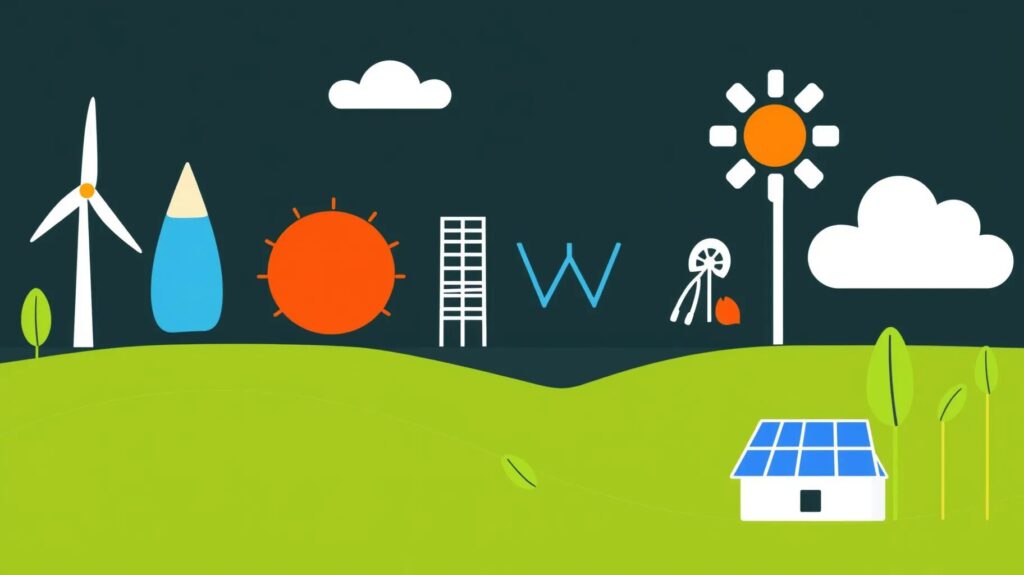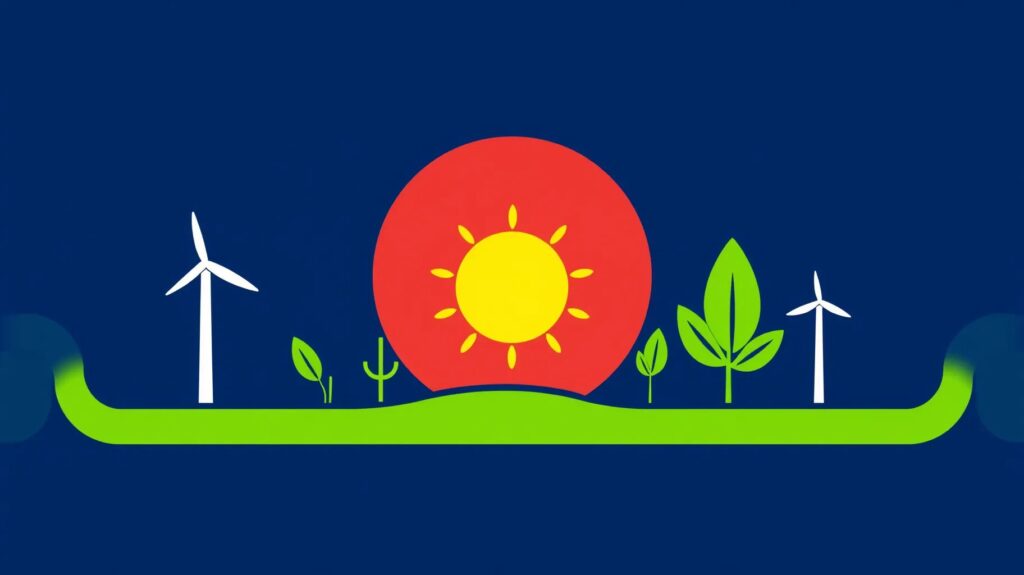
AI’s Role in the Renewable Energy Revolution
The rise of renewable energy sources like solar and wind has marked a significant shift towards a sustainable future. Yet, the intermittent nature of these energy sources presents challenges. This is where artificial intelligence (AI) steps in, acting as a catalyst for transforming how we harness and manage renewable energy. By optimizing various aspects—from energy production to storage and distribution—AI is playing a pivotal role in enhancing the efficiency of renewable energy systems.
At its core, AI excels in processing vast amounts of data, making it invaluable in predicting energy output, optimizing storage solutions, and ensuring that energy grids operate smoothly. This not only increases efficiency but also significantly reduces operational costs, making renewable energy a more viable and competitive option.
Predicting Renewable Energy Production with AI
One of the most critical challenges in renewable energy is predicting the amount of energy that will be produced at any given time. Solar panels generate different amounts of electricity depending on factors like sunlight intensity, cloud cover, and even the angle of the sun. Similarly, wind turbines are at the mercy of wind speed and direction. Inaccurate predictions can lead to energy shortages or overproduction, both of which are costly and inefficient.
AI comes to the rescue by using advanced machine learning algorithms to analyze historical weather data, real-time environmental conditions, and even satellite imagery. These insights allow AI to predict energy production with remarkable accuracy. For instance, companies like Google’s DeepMind have developed AI systems that predict wind energy output 36 hours in advance, improving the efficiency of wind farms by up to 20%. Such precise forecasting enables better planning and reduces reliance on fossil fuel backup systems.
Enhancing Energy Storage: A Game-Changer
Energy storage is another critical area where AI is making a substantial impact. The ability to store excess energy generated during peak production times for use during low production periods is essential for stabilizing renewable energy supplies. Traditional storage methods, such as batteries, have limitations, including capacity constraints and degradation over time.
AI optimizes energy storage by determining the best times to store energy and the most efficient ways to use it later. By analyzing patterns in energy production and consumption, AI can direct energy flow to storage systems when it’s most cost-effective and discharge it when demand is high. This not only reduces waste but also lowers costs associated with energy storage. Additionally, AI helps in extending the life of batteries by preventing overcharging and deep discharging, which are common causes of battery degradation.
Smart Grid Management: AI’s Power Play
Managing the distribution of energy across vast and complex power grids is a daunting task. With the integration of renewable energy sources, which are inherently variable, this task becomes even more challenging. AI is instrumental in smart grid management, where it helps balance supply and demand, reduce energy losses, and ensure that electricity is delivered efficiently to where it’s needed most.
Smart grids equipped with AI can automatically adjust the flow of electricity based on real-time data. For example, if a sudden drop in wind energy production is detected, the AI can quickly switch to alternative sources or draw from stored energy to maintain a steady supply. This dynamic adjustment minimizes disruptions and reduces the need for expensive and polluting backup power plants. AI’s ability to manage these grids also helps in integrating a higher percentage of renewable energy into the grid, making the overall system more sustainable.
Case Study: Solar Energy Optimization

A compelling example of AI in action can be found in the solar energy sector. Companies like Stem Inc. are using AI to optimize solar energy production and consumption. Their AI-driven energy storage systems analyze data from solar panels to predict the best times to store and use solar energy. This not only maximizes the efficiency of solar power but also reduces reliance on the grid during peak hours, leading to significant cost savings.
In regions like California, where solar energy is abundant but variable, AI has enabled homes and businesses to become more energy-independent. By predicting solar output and managing energy storage intelligently, AI has allowed these solar systems to operate more efficiently and reduce electricity bills by up to 30%. This case study highlights the transformative potential of AI in making solar energy more practical and cost-effective for everyday use.
Wind Energy: Harnessing AI for Better Performance
Wind energy, like solar, faces the challenge of inconsistency. The speed and direction of wind can vary, leading to fluctuating energy outputs. AI is stepping in to address these issues, transforming wind farms into more reliable and efficient sources of power.
Through machine learning algorithms, AI can predict wind patterns with remarkable accuracy. This allows wind turbines to adjust their operations in real-time, maximizing energy capture even during less-than-ideal wind conditions. For instance, AI can optimize the angle of turbine blades based on real-time wind data, improving energy production by up to 10%.
Reducing Operational Costs with AI-Powered Analytics
Beyond optimizing energy production, AI is also helping renewable energy companies cut down on operational costs. AI-powered analytics can identify inefficiencies and suggest improvements in real-time, reducing waste and saving money.
For example, AI can monitor the performance of solar panels or wind turbines and predict when maintenance is needed. By addressing issues before they lead to significant downtime, companies can avoid costly repairs and extend the lifespan of their equipment. In one case, a European wind farm operator used AI to reduce maintenance costs by 30%, illustrating the significant financial benefits of AI integration.
AI in Hybrid Energy Systems: Balancing the Load
Hybrid energy systems, which combine multiple renewable energy sources, are becoming increasingly popular as they offer greater reliability and flexibility. However, managing these systems can be complex, especially when integrating solar, wind, and battery storage.
AI plays a crucial role in balancing the load between these different energy sources. By analyzing data from each component of the system, AI can determine the most efficient way to use available resources. For example, if solar energy production drops, AI can seamlessly shift the load to wind or battery storage, ensuring a continuous power supply.
Improving Energy Forecasting for Grid Stability
Grid stability is a major concern as renewable energy sources become a larger part of the energy mix. Fluctuations in energy production can lead to instability, potentially causing blackouts or other disruptions. AI improves energy forecasting, helping to stabilize the grid and prevent such issues.
By analyzing historical data, weather patterns, and real-time grid conditions, AI can predict fluctuations in energy supply and demand with high accuracy. This allows grid operators to make informed decisions, such as ramping up energy production or drawing on reserves to maintain stability. As a result, AI helps to create a more resilient and reliable energy grid.
AI-Driven Maintenance: Preventing Downtime and Failures
Maintenance is a critical aspect of running renewable energy systems. However, traditional maintenance methods can be costly and inefficient, leading to unnecessary downtime and higher operational costs.
AI-driven maintenance systems use predictive analytics to identify potential issues before they become major problems. By analyzing data from sensors on solar panels, wind turbines, and other equipment, AI can detect early signs of wear and tear. This allows for targeted maintenance, reducing downtime and extending the lifespan of the equipment.
For instance, AI has been used to monitor wind turbines, predicting mechanical failures weeks before they occur. This proactive approach to maintenance has helped companies avoid costly repairs and minimize downtime, leading to more efficient and cost-effective operations.
Environmental Benefits of AI-Optimized Renewable Energy

AI’s impact on renewable energy extends beyond efficiency and cost savings; it also plays a critical role in enhancing the environmental benefits of these clean energy sources. By optimizing energy production, storage, and distribution, AI reduces the reliance on fossil fuels, leading to lower greenhouse gas emissions and a smaller carbon footprint.
For example, AI-driven energy management systems can ensure that renewable energy is used whenever possible, reducing the need for fossil fuel-based backup power. Additionally, by improving the efficiency of renewable energy systems, AI helps decrease the amount of land and resources required for energy production. This results in less environmental disruption and preserves natural habitats.
In the context of climate change, AI’s ability to maximize the use of renewable energy is crucial. By reducing emissions and minimizing the environmental impact of energy production, AI is helping to accelerate the transition to a more sustainable and environmentally friendly energy landscape.
Overcoming Challenges: Integrating AI with Existing Infrastructure
Despite its many benefits, integrating AI into existing energy infrastructure is not without its challenges. Many energy systems were not designed with AI in mind, and retrofitting them to accommodate AI technologies can be complex and costly. However, the potential benefits often outweigh the initial investment.
One of the key challenges is data integration. AI requires vast amounts of data to function effectively, but older energy systems may not have the necessary sensors or data collection capabilities. Upgrading these systems to provide real-time data can be expensive and time-consuming.
Another challenge is the need for specialized expertise. Developing and maintaining AI systems requires a deep understanding of both AI technology and the specific needs of the energy sector. This can be a barrier for smaller companies or those with limited technical resources.
Despite these challenges, the integration of AI into renewable energy systems is progressing rapidly. Many companies are finding that the long-term benefits of AI—such as increased efficiency, reduced costs, and improved environmental performance—justify the initial investment. As AI technology continues to evolve, it is likely that these challenges will become easier to overcome, paving the way for even more widespread adoption of AI in the energy sector.
The Future of AI in Renewable Energy
The future of renewable energy is inextricably linked with AI. As AI technology continues to advance, its role in optimizing renewable energy systems will only grow. Emerging trends suggest that AI will become increasingly integrated with other advanced technologies, such as the Internet of Things (IoT) and blockchain, to create even more efficient and resilient energy systems.
For instance, the combination of AI and IoT could enable more precise control of energy consumption in homes and businesses, reducing waste and lowering costs. Blockchain, on the other hand, could facilitate more transparent and secure energy transactions, making it easier to manage decentralized energy systems that rely on multiple renewable sources.
In the coming years, we can expect to see AI playing a central role in the development of smart cities, where renewable energy systems are integrated with AI-driven infrastructure to create sustainable and efficient urban environments. AI will also be crucial in scaling up renewable energy production to meet the growing global demand for clean energy.
Investing in AI Technologies: A Smart Move for Energy Companies
As the benefits of AI in renewable energy become increasingly clear, more and more energy companies are investing in AI technologies. These investments are not just about improving efficiency and reducing costs; they are also about staying competitive in an industry that is rapidly evolving.
Companies that embrace AI are likely to gain a significant competitive advantage. By optimizing their energy production, storage, and distribution systems, they can reduce operational costs, increase profitability, and offer more competitive pricing to their customers. Additionally, companies that lead in AI adoption are better positioned to meet the growing demand for sustainable energy solutions and to comply with increasingly stringent environmental regulations.
Investing in AI is also a way for energy companies to future-proof their operations. As AI technology continues to evolve, those companies that have already integrated AI into their systems will be better equipped to adapt to new developments and to take advantage of emerging opportunities in the renewable energy sector.
Conclusion: AI as the Key to a Sustainable Energy Future
AI is revolutionizing the renewable energy sector, making it more efficient, cost-effective, and environmentally friendly. By optimizing energy production, storage, and distribution, AI is helping to overcome the challenges associated with renewable energy and to accelerate the transition to a sustainable energy future.
As AI technology continues to advance, its role in the energy sector will only grow, driving further innovations and helping to create a more sustainable and resilient energy system. For energy companies, investing in AI is not just a smart move; it is essential for staying competitive and meeting the demands of the future.
The integration of AI with renewable energy is more than just a technological advancement; it is a critical step towards achieving a sustainable, low-carbon energy future that benefits both the economy and the environment. The time to embrace AI in renewable energy is now, and those who do will be at the forefront of the next energy revolution.
Resources
Books & Academic Papers:
- “Artificial Intelligence and Renewable Energy Systems: A Practical Introduction” by Soteris A. Kalogirou
This book offers a comprehensive introduction to how AI can be applied to renewable energy systems, including case studies and practical examples. - “Smart Grids and Renewable Energy Integration” by Georgios Tsaousoglou
This book delves into the role of smart grids and how AI can optimize renewable energy integration. - “Deep Reinforcement Learning for Renewable Energy Integration” by Ma and others (2021)
A scholarly paper exploring the use of deep reinforcement learning, a branch of AI, to manage renewable energy resources efficiently. - “AI-Based Optimization Techniques in Renewable Energy Systems” (Various Authors, 2020)
This journal article provides an overview of various AI-based optimization techniques used in renewable energy.
Online Courses & Tutorials:
- Coursera: “AI For Energy: Applications and Trends”
This course provides insights into how AI is transforming the energy sector, with a focus on renewable energy applications. - edX: “Smart Grids: Electricity Networks of the Future”
Learn about smart grids and the role of AI in modernizing the electricity grid to integrate renewable energy sources. - Udemy: “Machine Learning for Renewable Energy Projects”
A practical course that teaches how to apply machine learning techniques to optimize renewable energy systems.
Industry Reports:
- “AI in Energy Market: Global Market Outlook and Forecast” by MarketsandMarkets (2023)
An industry report detailing the market trends, growth prospects, and impact of AI in the energy sector. - “Renewable Energy and AI: Trends, Impacts, and the Future” by Deloitte Insights (2022)
A report analyzing how AI is influencing the renewable energy industry, including case studies and future trends. - “The Role of AI in Achieving Net-Zero Emissions” by McKinsey & Company (2021)
This report discusses how AI can be leveraged to accelerate the transition to renewable energy and achieve net-zero emissions.
Websites & Blogs:
- Google AI Blog
Keep up-to-date with how Google’s AI initiatives, like DeepMind, are being applied to renewable energy. - Renewable Energy World
A leading website for the latest news, trends, and insights in the renewable energy industry, including AI applications. - Energy Central
A platform for professionals in the energy industry, featuring articles, white papers, and discussions on AI’s role in renewable energy.
Case Studies & White Papers:
- “DeepMind’s Wind Power Predictions”
This white paper by Google DeepMind showcases how AI has improved the efficiency of wind farms by predicting wind energy output. - “AI-Optimized Solar Energy Management Systems” by Stem Inc.
A case study on how AI-driven energy storage systems are maximizing solar energy efficiency and reducing costs. - “AI-Powered Smart Grids: Enhancing Grid Stability and Efficiency” by Siemens
This white paper discusses how Siemens is integrating AI into smart grid technology to improve the stability and efficiency of energy distribution.
For more detailed insights, you can visit these articles: